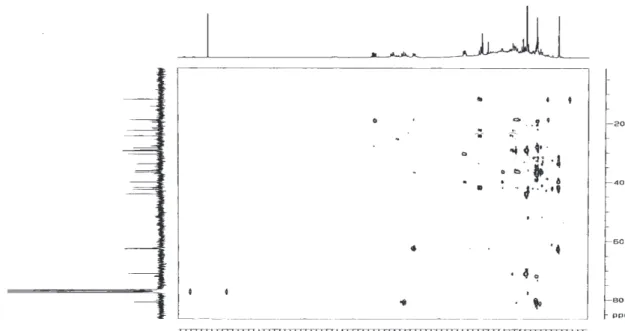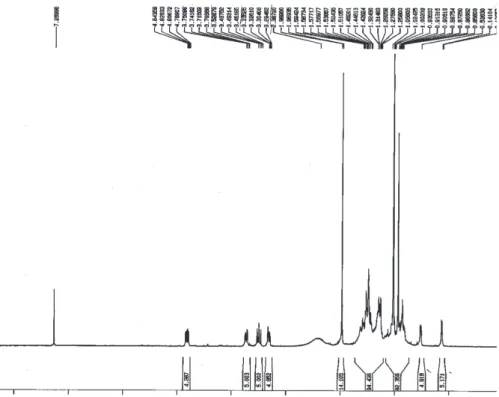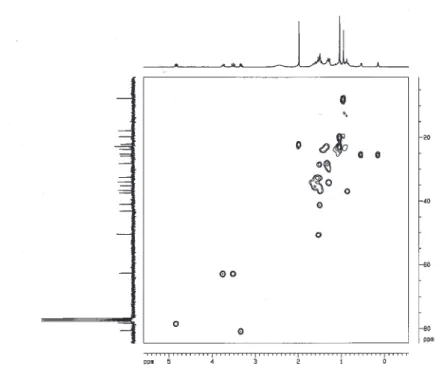Printed in Brazil - ©2006 Sociedade Brasileira de Química 0103 - 5053 $6.00+0.00
A
rti
c
le
*e-mail: mary@dqoi.ufc.br
Diterpenes from Erythroxylum barbatum
Cláudio C. dos Santos,a Mary Anne S. Lima,*,a Raimundo Braz Filhob and Edilberto R. Silveiraa
a
Curso de Pós-Graduação em Química Orgânica, Departamento de Química Orgânica e Inorgânica, Universidade Federal do Ceará, CP 12.200, 60455-760 Fortaleza-CE, Brazil
b
Setor de Química de Produtos Naturais, Universidade Estadual do Norte Fluminense, 28013-600 Campos-RJ, Brazil
Das raízes de Erythroxylum barbatum foram isolados dois novos diterpenos ent- rosan-1-ona-5α,15ξ,16-triol (1) e ent-11α-acetoxi-devadarano-15ξ,16-diol (2), além do ent- devadarano-15ξ,16-diol (erythroxidiol X, 3) e do procesterol. Investigação do lenho do caule forneceu o
ent-devadarano-11α,15ξ,16-triol (erythroxitriol Q, 4), o ent-devadarano-7β,15ξ,16-triol (hidroxidevadarool, 5), o β-sitosterol e seu glicosídeo. A caracterização estrutural, inclusive a estereoquímica relativa dos compostos, foi estabelecida com base em métodos espectroscópicos, particularmente RMN uni e bidimensional, e comparação com dados da literatura.
Two new diterpenes ent-rosan-1-one-5α,15ξ,16-triol (1) and ent -11α-acetoxy-devadarane-15ξ,16-diol (2) were isolated from roots of Erythroxylum barbatum, in addition to the known diterpenes ent-devadarane-15ξ,16-diol (erythroxydiol X, 3) and procesterol. Investigation of the trunk heartwood furnished the ent-devadarane-11α,15ξ,16-triol (erythroxytriol Q, 4), ent -devadarane-7β,15ξ,16-triol (hydroxydevadarool, 5), β-sitosterol and its glucoside. Structural characterization, including the relative stereochemistry of all compounds, was established on the basis of spectroscopic methods, particularly 1D and 2D NMR, and comparison with data from literature.
Keywords: Erythroxylum barbatum, diterpenes, ent-rosan-1-one-5α,15ξ,16-triol, ent-11α-acetoxy-devadarane-15ξ,16-diol
Introduction
The genus Erythroxylum comprises 250 species, which are widely distributed throughout the tropics, with large areas of diversity in South America, Africa and Madagascar. This genus is best known as the source of the tropane alkaloids and flavonoids as chemotaxonomic markers,1-4 but also as a prolific source of assorted diterpenes.5-7 However, with exception of the cocaine-producing species E. coca and E. novogranatense,8 few attention has been focused on the phytochemical analysis of this genus and the chemical constituents of many species used in traditional medicine still remain unknown.
Erythroxylum barbatum O. E. Schulz, a small tree endemic to the Northeast of Brazil, is the only species placed by Schulz in the Pogonophorum section of the genus.9 Our previous phytochemical investigation on this species revealed the presence of diterpene, prenylated chalcones, pterocarpans, coumarin and steroid,10 and a
more recent report led to the isolation of two kaurene diterpenoids with a unusual skeleton.11 This work reports the isolation, from the roots, of the new diterpenes ent -rosan-1-one-5α,15ξ,16-triol (1) and ent -11-α-acetoxy-devadarane-15ξ,16-diol (2), in addition to the known
ent-devadarane-15ξ,16-diol (3) (erythroxydiol X) 10 and procesterol. Investigation of the trunk heartwood yielded the ent-devadarane-11α,15ξ,16-triol (4) (erythroxytriol Q),12 ent-devadarane-7β,15ξ,16-triol (5) (hydroxy-devadarool),13 β-sitosterol and its glucoside.
Results and Discussion
Compound 1 was isolated as a colorless resin. The IR spectrum showed characteristic absorption of hydroxy group at 3421 cm-1 and keto group at 1708 cm-1.
1305 Diterpenes from Erythroxylum barbatum
Vol. 17, No. 7, 2006
ABC pattern suggesting the presence of a 1,2-glycol system. These observations were further confirmed by the 1H-1H COSY experiment through the cross-peaks for the geminal coupling of the methylene hydrogens at δH 3.76 and 3.54 (2H-16), and for both of them with the hydrogen at δH 3.34 (H-15). Further, a spin subsystem constituted by two adjacent methylene hydrogens at δH 2.39 (m, H-2) and 1.48 (m, H-3), which were placed between a quaternary carbon and the keto group was characterized.
The 13C NMR spectrum exhibited resonances for four methyl groups, eight methylenes, three methines, and five non-hydrogenated carbons, one of which was associated to a carbonyl group (δC 212.6).
Pimarane, isopimarane and rosane skeletons have four angular methyl groups and can be differentiated by the relative stereochemistry at C-3 and the position of the methyl at C-20, respectively. Rosanes arise from migration of the C-10 methyl group of pimaranes to the C-9 and occur in both enantiomeric series. The placement of a methyl group at C-9 in a rosane skeleton for compound 1 was readily established by detailed examination of the HMBC spectrum, through corre-lations of the hydrogen at δH 2.05 (H-10) with the methyl group at δC 11.9 (C-20) and the carbon at δC 24.2 (C-6). Furthermore, were observed correlations for the methylene hydrogens at δH 1.48 (H-3) with the carbons at δC 29.5 (C-19) and 29.3 (C-18), and of the methylene group at δH 1.40 and 1.09 (H-6) with the carbons at δC 62.8 (C-10) and 40.2 (C-8), respectively. In the same way, correlations of the signal relative to methyl groups at δH 1.18 (H-18, H-19) and of the hydrogen at δH 1.70 (H-7) with the carbon at δC 71.2 (C-5), indicated that the location of the tertiary alcohol at C-5 could be assumed. The position of the carbonyl group at C-1 was deduced by the correlation of its 13C NMR chemical shift at δC 212.6 with the hydrogens at
δH 2.39 (H-2) and 1.48 (H-3). The absolute configur-ation of 1 was not ascertained particularly because its levorotatory property, however, it is reasonable to assume that it possess an absolute stereochemistry belonging to the enantio-series, considering the ent -rosane skeleton of diterpenoids isolated previously from
Erythroxylum species5,7 that led to the “Absolute Stereochemistry Biogenetic Rule” suggested by Sukh Dev.14 Thus, the structure of 1 could be identified as the new ent-rosan-1-one-5α,15ξ,16-triol.
Compound 2, a white amorphous solid, showed a molecular ion at m/z 364, compatible with a molecular formula C22H36O4. The IR spectrum revealed absorption of hydroxyl group at 3456 cm-1, carbonyl ester at 1724 cm-1 and C-O stretching at 1249 cm-1.
The 1H NMR spectrum showed the presence of three methyls groups attached to quaternary carbons at δH 1.03 (s, 6H, H-17 and H-18) and 0.94 (s, H-20), associated with the presence of the shielded doublets at δH 0.14 (d, J 4.4 Hz, H-19a) and 0.53 (d, J 4.4 Hz, H-19b) characteristic of a tetrasubstituted cyclopropane ring, suggesting a devadarane skeleton for 2. Like compound 1, one ABC system relative to an 1,2-glycol moiety was observed at
δH 3.32 (dd, 1H, J 9.3, 2.7 Hz, H-15), 3.51 (dd, 1H, J 10.8, 9.3 Hz, H-16a) and 3.74 (dd, 1H, J 10.8, 2.7 Hz, H-16b). In addition, a deshielded signal assignable to an acetylated oxymethine hydrogen at δH 4.82 (dd, J 11.1, 5.2 Hz, H-11), was confirmed by the presence of a methyl group at δH 1.99 (s, H-21). All the above observations were consistent with the cross-peak correlations observed on the 1H,1H-COSY experiment.
Comparative analysis of BB and DEPT-13C NMR (Table 1) spectra revealed 22 signals. From these data one can easily deduce the presence of three oxygen bearing saturated carbons at δC 62.5 (CH2), 78.2 (CH) and 80.6 (CH), and 18 other sp3 not functionalized carbon signals (4 methyls, 8 methylenes, 2 methines and 4 quaternaries), in addition of a characteristic carbonyl of an ester function at δC 162.5. Carbonyl carbons of acetate derivatives of alcohols usually appear around 170 ppm, thus the relative shielding of the acetate carbonyl (∆δ ~ 8.0 ppm) may indicates stereochemical implications related to positioning either as α-equatorial or β-axial as observed for other devadarane diterpenoids.12 The unambiguous assignment of all carbon and hydrogens was possible for the HMQC spectrum analysis (Table 1).
Besides the other NMR data already discussed, further evidences of a devadarane skeleton merged from the observed long-range correlations in the HMBC spectrum. In this experiment were observed correlation signals between hydrogens of the cyclopropane moiety at δH 0.14 and 0.53 (2H-19) with carbons at δC 22.6 (C-18), 33.9 (C-3) and 50.3 (C-10). Like compound 1, correlations of the oxymethine hydrogen at δH 3.32 (H-15) with the carbons at δC 19.7 (C-17), 35.2 (C-14) and 36.6 (C-12) confirmed the position of the ethyl 1,2-glycol system at C-13 and provided additional proof for the suggested structure. The acetyl group at C-11 was confirmed due to the correlation of the oxymethine hydrogen at δH 4.82 (H-11) with the carbons at δC 7.7 (C-20) and 50.3 (C-10) and 162.5 (C-22). The shielding effect observed for the 13C NMR signal of the C-20 methyl group at δC 7.7, when compared with related devadarane diterpenoids (~δC 12.0),
10 is attributed to a
et al. J. Braz. Chem. Soc.
equatorial oxy group at C-11. On the basis of biogenetic arguments, along with the knowledge of occurrence of
ent-devadarane diterpenoids only in Erythroxylum spp., we can suggest that compound 2 also belongs to the
enantio series. From the foregoing evidence, compound
2 was identified as the new natural α -acetoxy-devadarane-15ξ,16-diol, although it was cited previously in the literature as the chemical derivative of compound
4,12 this paper comprises the first report of 2 as a natural product.
The NOESY experiment was an important tool to reach the final relative stereochemistry of compound 5. In particular, the orientation of the H-7 was determined to be axial, as revealed by the diagnostic NOE cross-peak for the hydrogen H-7 at δH 3.42 with the CH3-20 at
δH 0.81. This was in agreement with the relative stereo-chemistry already reported for hydroxydevadarool, isolated previously from Erythroxylum monogynum.13
Up to now the occurrence of devadarane diterpenoids in higher plants is restricted to species of the
Erythroxylum genus. Their presence is remarkable and
the potential as chemical markers was already discussed.13 Physical and spectroscopic data comparison of compounds 3, 4, and 5 with those from literature made possible theiridentification as ent-devadaran-15ξ,16-diol (erythroxydiol X),10 ent-devadaran-11α,15ξ,16-triol (erythroxytriol Q)12 and ent-devadaran-7β,15ξ,16-triol (hydroxydevadarool),13 respectively. To the best of our acknowledge this is the first report of compounds 4 and
513C NMR spectroscopic data.
None of the isolated diterpenes (1-5) showed any cytotoxicity activity against five tumor cell lines: two human leukemias (HL-60 and CEM), human breast adenocarcinoma (MCF-7), human colon adenocarcinoma (HCT-8) and murine melanoma (B16).
Experimental
General procedures
Melting points were obtained on a Mettler FP82HT apparatus and are uncorrected. IR spectra were recorded Table 1.1H and 13C NMR data for compounds 1, 2, 4 and 5 (CDCl
3)
Carbon 1H NMR 13C NMR
1a 2a 1a 2a 4b 5b
1 1.29 212.6 22.8 25.0 23.2
2 2.39 1.31 42.6 28.1 29.6 19.6
1.58
3 1.48 1.28 44.2 33.9 35.4 32.2
4 44.2 17.8 18.8 16.7
5 71.2 25.8 27.7 25.2
6 1.40 0.86 24.2 32.5 33.3 43.4
1.09 1.60
7 1.70 0.92 22.6 23.7 24.5 69.6
1.20 1.59
8 1.86 1.45 40.2 40.9 42.5 48.5
9 42.0 43.1 45.6 38.7
10 2.05 1.49 62.8 50.3 52.5 49.8
11 1.67 4.82 (dd, J 11.1, 5.2 Hz) 33.9 78.2 76.8 34.0
1.42
12 1.40 1.59 28.5 36.6 41.1 31.2
1.08
13 36.8 37.4 38.8 36.5
14 1.40 1.59 36.3 35.2 38.1 28.8
1.04
15 3.34 (dd, J 9.4, 2.9 Hz ) 3.32 (dd, J 9.3, 2.7 Hz) 80.9 80.6 82.4 81.9 16 3.76 (dd, J 10.7, 2.9 Hz) 3.51 (dd, J 10.8. 9.3 Hz) 62.7 62.5 63.6 62.6
3.54 (dd, J 10.7, 9.4 Hz) 3.74 (dd, J 10.8, 2.7 Hz)
17 1.00 (s) 1.03 (s) 18.9 19.7 20.3 18.1
18 1.18 (s) 1.03 (s) 29.3 22.6 23.3 21.7
19 1.18 (s) 0.14 (d, J 4.4 Hz) 29.5 25.2 26.0 24.5
0.53 (d, J 4.4 Hz)
20 0.58 (s) 0.94 (s) 11.9 7.7 7.1 12.2
21 1.99 (s) 22.0
22 162.5
1307 Diterpenes from Erythroxylum barbatum
Vol. 17, No. 7, 2006
using a Perkin Elmer 1000 spectrophotometer. Optical rotations were measured on a Perkin Elmer 341 polarimeter. Mass spectra were obtained on a Hewlett-Packard 5971 mass spectrometer by electron impact ionization (70 eV). 1H and 13C NMR where recorded on a Bruker Avance
DRX-500 or DPX-300 instruments. All compounds were visualized on TLC using the vanillin-sulfuric acid reagent.
Plant material
Roots and trunk heartwood of Erythroxylum barbatum
O. E. Schulz were collected in August 2002, in Acarape County, Ceará State, Northeast of Brazil. The plant material was identified by Dr. Edson Paula Nunes of the Herbário Prisco Bezerra (EAC), Departamento de Biologia, Universidade Federal do Ceará, Brazil, where the voucher specimen (No. 28815) was deposited.
Extraction and isolation
Roots (1.7 kg) and trunk heartwood (3.3 kg) of E. barbatum were separately pulverized and extracted with hexane at room temperature. Both plant residues from the hexane extraction were extracted with ethanol. All the solvents were removed under reduced pressure to give the correspondent extracts.
The EtOH extract (30.0 g) from roots was dissolved in a mixture of MeOH:H2O 1:1 and submitted to partition successively with hexane, CHCl3, EtOAc and MeOH. The CHCl3 fraction (7.0 g) was submitted to silica gel flash chromatography using CHCl3 and EtOAc as binary mixtures with increasing polarity, to give several fractions which were combined according to TLC analysis. Fraction 23 (1.2 g) was further purified over Sephadex LH-20 by elution with MeOH to afford compound 1 (13.0 mg). Coarse chromatography on a silica gel column of the hexane extract (3.2 g) by elution with hexane, CH2Cl2, EtOAc and MeOH yielded the correspondent fractions. The EtOAc fraction (0.8 g) was further purified over Sephadex LH-20 by elution with MeOH to furnished 15 fractions. Successive flash chromatography of fraction 5-11 furnished the pure compounds 2 (16.2 mg), 3 (4.0 mg) and procesterol (9.7 mg).
The EtOH extract of the trunk heartwood (75.9 g) was coarsely fractionated on a silica gel column by elution with hexane, CHCl3 and EtOAc. Isocratic silica gel flash chromatography of the EtOAc fraction (5.3 g) using CHCl3:EtOAc(1:1) as eluent afforded compounds 4 (14.9 mg), 5 (11.6 mg), β-sitosterol (10.5 mg) and β-sitosterol glucoside (49.8 mg).
Ent-Rosan-1-one-5α,15ξ,16-triol (1)
Colorless resin. [α]2 D
0: -15o (CHCl
3 ; c 0.16). IR (film) νmax /cm-1: 3421, 2933, 2867, 1708, 1463, 1340, 1257, 1026, 756. EIMS m/z (rel. int.): 338 [M•+](absent), 320 (3), 304 (20), 243 (23), 199 (20), 187 (23), 149 (25), 135 (51), 121 (58), 109 (62), 95 (100), 81 (75), 57 (72), 55 (98). 1H and 13C NMR data: see Table 1.
Ent-11α-Acetoxy-devadarane-15ξ,16-diol (2)
White amorphous solid. [α]2 D
0: -16.0o (CHCl
3; c 0.26). IR (film) νmax /cm-1: 3456, 2929, 2862, 1724, 1657, 1459, 1377, 1249, 1377, 1249, 1174, 1024, 975. EIMS m/z (rel. int.): 364 [M•+] (2), 322 (2), 304 (10), 261 (7), 243 (34), 187 (17), 173 (15), 161 (18), 149 (55), 133 (32), 119 (49), 107 (48), 95 (71), 81 (69), 57 (79), 55 (100). 1H and 13C NMR: see Table 1.
Acknowledgments
The authors are grateful to CNPq, CAPES, PADCT, PRONEX, FUNCAP, FINEP for the fellowships and financial support.
Supplementary Information
Supplementary data for compounds 1 and 2 are available free of charge at http://jbcs.org.br, as PDF file.
References
1. Griffin, W. J.; Lin, G. D.; Phytochemistry2000, 53, 623. 2. Bohm, A. F.; Loo, T.; Nicholls, K. W.; Plowman, T.;
Phytochemistry1988, 27, 833.
3. Jonhson E.; Schmidt, W. F.; Norma, H. A.; Biochem. Syst. Ecol. 1998, 26, 743.
4. Inigo, R. P. A.; Pomilio, A. B.; Phytochemistry1985, 24, 347. 5. Kapadi, A. H.; Soman, R.; Sobti, R. R.; Dev, S.; Indian J. Chem.,
et al. J. Braz. Chem. Soc.
6. Soman, R.; Dev, S.; Indian J. Chem., Sect B1983, 22, 978. 7. Ansell, S. M.; Pegel, K. H.; Taylor, D. A. H.; Phytochemistry
1993, 32, 937.
8. Plowman, T.; Adv. Econ. Bot. 1984, 1, 62. 9. Schulz, O. E.; A. Pflanzer 1907, 134(Heft29), 101
10. Santos, C. C.; Lima, M. A. S.; Silveira, E. R.; Biochem. Syst.
Ecol. 2003, 31, 661.
11. Santos, C. C.; Lima, M. A. S.; Braz-Filho, R.; Simone, C. A.; Silveira, E. R.; Magn. Reson. Chem. 2005, 43, 1012.
12. Connolly, J. D.; Gunn, D. M.; McCrindle, R.; Murray, R. D. H.; Overton, K. H.; J. Chem. Soc. (C) 1967, 668.
13. Soman, R.; Dev, S.; Misra, R.; Pandey, R. C.; Tetrahedron Lett. 1964, 49, 3767.
14. Dev, S.; Pure Appl. Chem.1979, 51, 837.
Received: December 28, 2005
J. Braz. Chem. Soc., Vol. 17, No. 7, S1-S7, 2006. Printed in Brazil - ©2006 Sociedade Brasileira de Química 0103 - 5053 $6.00+0.00
S
u
p
p
le
m
e
nta
ry
Inf
o
rm
a
ti
o
n
*e-mail: mary@dqoi.ufc.br
Diterpenes from Erythroxylum barbatum
Cláudio C. dos Santos,a Mary Anne S. Lima,*,a Raimundo Braz Filhob and Edilberto R. Silveiraa
a
Curso de Pós-Graduação em Química Orgânica, Departamento de Química Orgânica e Inorgânica, Universidade Federal do Ceará, CP 12.200, 60455-760 Fortaleza-CE, Brazil
b
Setor de Química de Produtos Naturais, Universidade Estadual do Norte Fluminense, 28013-600 Campos-RJ, Brazil
Figure S1. 1H NMR spectrum (CDCl
et al. J. Braz. Chem. Soc.
Figure S2. 13C NMR spectrum (CDCl
3, 75 MHz) of compound 1.
3 Diterpenes from Erythroxylum barbatum
Vol. 17, No. 7, 2006
Figure S4. DEPT NMR experiment (CDCl3, MHz) of compound 1.
et al. J. Braz. Chem. Soc.
Figure S6. HMBC NMR experiment of compound 1.
5 Diterpenes from Erythroxylum barbatum
Vol. 17, No. 7, 2006
Figure S8. 1H NMR spectrum (CDCl
3, 300 MHz) of compound 2.
Figure S9. 13C NMR spectrum (CDCl
et al. J. Braz. Chem. Soc.
Figure S10. 13C NMR spectrum (75 MHz, CDCl
3) of compound 2.
7 Diterpenes from Erythroxylum barbatum
Vol. 17, No. 7, 2006
Figure S12. HSQC NMR experiment of compound 2.







